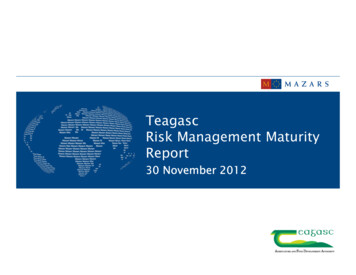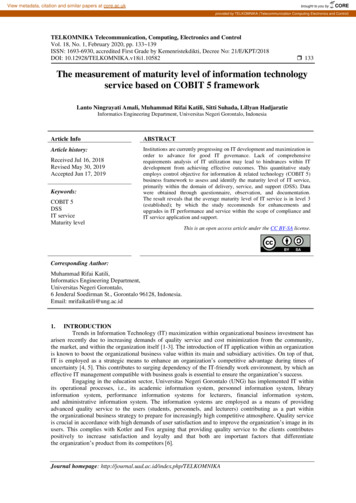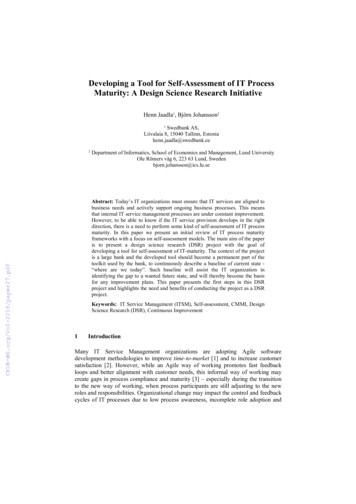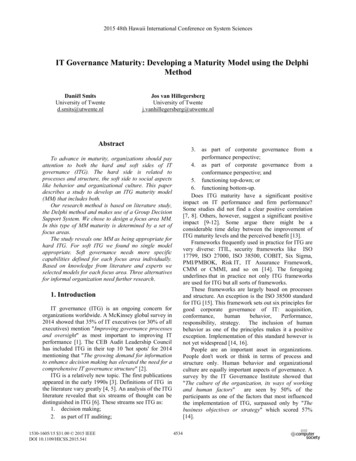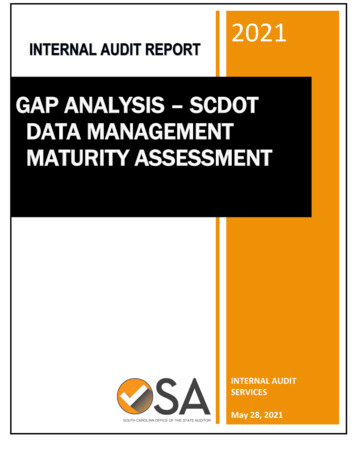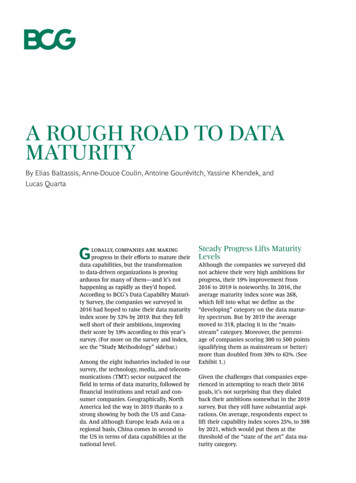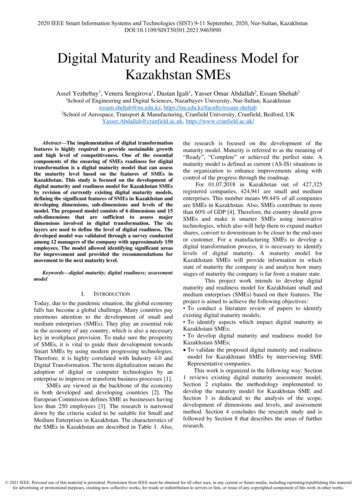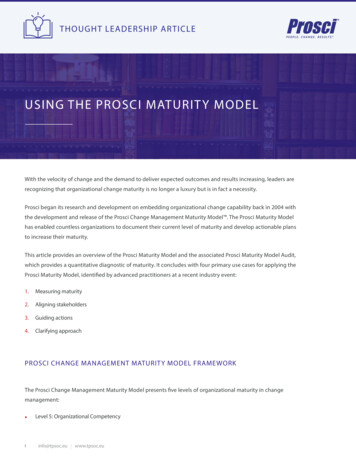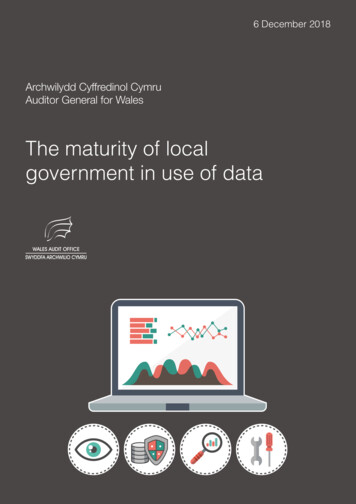
Transcription
6 December 2018Archwilydd Cyffredinol CymruAuditor General for WalesThe maturity of localgovernment in use of dataThe maturity of local government in use of data1
2The maturity of local government in use of data
This report has been prepared for presentationto the National Assembly under the PublicAudit (Wales) Act 2004.The Wales Audit Office study team was managed byNick Selwyn and comprised Matt Brushett, PhilippaDixon, Steve Frank, Martin Gibson, Gareth Jones,Euros Lake and Sara Leahy.Auditor General for WalesWales Audit Office24 Cathedral RoadCardiffCF11 9LJThe Auditor General is independent of the National Assembly and government. He examinesand certifies the accounts of the Welsh Government and its sponsored and related public bodies,including NHS bodies. He also has the power to report to the National Assembly on the economy,efficiency and effectiveness with which those organisations have used, and may improve the use of,their resources in discharging their functions.The Auditor General also audits local government bodies in Wales, conducts local governmentvalue for money studies and inspects for compliance with the requirements of the Local Government(Wales) Measure 2009.The Auditor General undertakes his work using staff and other resources provided by the Wales AuditOffice, which is a statutory board established for that purpose and to monitor and advise the AuditorGeneral. Auditor General for Wales 2018You may re-use this publication (not including logos) free of charge in any format or medium. Ifyou re-use it, your re-use must be accurate and must not be in a misleading context. The materialmust be acknowledged as Auditor General for Wales copyright and you must give the title of thispublication. Where we have identified any third party copyright material you will need to obtainpermission from the copyright holders concerned before re-use.For further information, or if you require any of our publications in an alternative format and/or language, please contact us by telephone on 029 2032 0500, or email info@audit.wales. Wewelcome telephone calls in Welsh and English. You can also write to us in either Welsh or Englishand we will respond in the language you have used. Corresponding in Welsh will not lead to a delay.Mae’r ddogfen hon hefyd ar gael yn Gymraeg.The maturity of local government in use of data3
Contents124Introduction6Summary report10Summary10Recommendations14A clear vision and effective leadership help create the cultureneeded to maximise the use of data, but few local authoritieshave focused on building an environment to get the most fromthe data they hold16Authority leaders need to do more to create a strong dataculture18Managing data as a corporate asset helps support integration,but few authorities have adopted standards that help unlockthis potential20With the growth in ‘big data’ it is important that local authoritiesensure the accuracy of their information, but data qualityremains an ongoing challenge for some22Citizens are required to provide the same informationmultiple times when applying for services, but authorities arenot integrating management systems to improve data efficiency23Local authorities are generally good at complying with dataprotection regulations, but do not always share the personaldata they collect with partners25The maturity of local government in use of data
3Local authorities are not investing sufficiently in developingtheir data management capacity and analytics skills314Local authorities use data to manage performance, but gapsand weaknesses mean that decisions are not always basedon a full range of evidence34Analysing performance is often limited36Local authorities are increasing the amount of open datathey publish37Decision making is not always driven by effective analysisor evaluation of data38AppendicesAppendix 1 – Study methodology42Appendix 2 – Glossary43Appendix 3 – Good practice in use of data44The maturity of local government in use of data5
IntroductionLocal authorities are slowly developing a culturethat values and uses data to its full potential to helpimprove services and outcomes1The growth of ‘big data’1 strategies in the private sector and the availabilityof ‘open data’2 has been unprecedented in recent times, and hasrevolutionised the way organisations make decisions. With the technologyavailable today, and the rate of technological change, data-driven decisionmaking is becoming the norm rather than the exception. However, is thisapproach extending to local authorities in Wales?2Being smart and strategic in using data brings many benefits for localauthorities, their partners, the communities they work in and the citizensthey serve. Making better use of data supports authorities to take betterand quicker decisions. It also allows authorities to make best use ofresources by identifying waste and inefficiency, and thus increasingproductivity. Most importantly, maximising use of data is good fordemocracy because it strengthens governance and accountability.1 Big data requires making sense of the vast amounts of data a local authority collects –processing, analysing and exploiting it for local authority, partner and community gain. Bigdata refers to digital information that is massive and varied, and that requires technology andbest practices to sort, process, store and analyse.2 Open data is the idea that some data should be freely available to everyone to use andrepublish as they wish, without restrictions from copyright, patents or other mechanisms ofcontrol. One of the most important forms of open data is open government data becausemaking government and local authority information available to the public can facilitatetransparency, accountability and public participation.6The maturity of local government in use of data
Exhibit 1 – Why making better use of data is important for local authoritiesWhy making betteruse of data isimportant for localauthoritiesIt supports localauthorities to make betteruse of resources andbecome more efficientIt provides insightinto what workswell and whyIt's good for democracyas decisions areevidence-based, openand transparentIt helps improveservice quality, reachand impactIt supportstransformation movingfrom reacting topreventing problemsIt supportscollaboration,integration andpartnership workingSource: Wales Audit OfficeThe maturity of local government in use of data7
3Local authorities are sitting on a ‘rich vein’ of personal, financial andcommunity level data that could help them deliver more efficient andeffective services. To do this, local authorities need to ensure they havethe right building blocks in place to unleash this data potential, specifically;agreed management standards, common coding, and the right culture,leadership and skills. The benefits of linking and using data, both withinlocal authorities and with partners, is challenging and authorities need toovercome some significant barriers if they are to maximise their use ofdata – Exhibit 2.Exhibit 2: The barriers to why local authorities are not making better use of dataWe cannotmake better useof data because.It is too risky to share datawith other public bodiesLocal authorities are often unwillingor feel unable to share personal data.Staff are not always clear on whatthey can share, with whom and inwhat circumstances. A reluctance toshare and use data hindersopportunities to drive efficiency.We lack the skills to analyse anduse the data to its full potenitalData is not valued as a keyresource, akin to staff and money,and whilst lots of information iscollected, authorites lack the skillsto analyse and unlock the potentialof the data.Source: Wales Audit Office8The maturity of local government in use of dataWe lack systems to re-useand add value in our dataSystems and processes are still focusedon using data once and the benefits ofthe data for other local authority servicesis not recognised. Because localauthorities have not set data standards,data is managed and used within silosand integration is not easy or pursued.The public do not trust us tomanage and make best use ofthe data we collect from themThe public are required to provide thesame information multiple times andhave little faith that local authorities linkup and integrate the information theyprovide to improve how they designand deliver services.
4Given these challenges, this study assesses whether local governmenthas the right building blocks and culture in place to capitalise on the data3that it holds. Our methods are set out in Appendix 1.3 This study is not about technology, software or hardware. Rather, it is a study of the keycharacteristics of a mature organisation that uses and values data to plan and deliverservicesThe maturity of local government in use of data9
Summary reportSummary5In Part 1 of the report, we study the strategic approach taken by localauthorities to making better use of data. We found that local authoritiesare not taking advantage of the massive amounts of data they collect tooperate as efficiently and as effectively as possible. Too often services andteams hold information in silos and use it for a single purpose. Becauseauthorities lack corporate data standards, duplication of information iscommon and integration of data often poor. Consequently, the potentialfor reusing data can be overlooked. In the age of big data, breaking downorganisational silos to drive a culture change is a priority. Authoritiesgenerally lack a clear vision for use of data and the leadership needed tohelp create the right strategic environment to maximise the benefits of datais not consistently present.6In Part 2 we summarise local authorities’ data protection work andhow they are progressing sharing data with other public bodies. Localauthorities can collect and hold very personal and sensitive data to helpthem deliver their services. This data can assist their partners but usingand sharing data is a delicate balancing act. We found that authoritieshave generally good arrangements for data protection but are often riskaverse and not prepared to share information, despite the availability ofnational approaches like the Wales Accord on the Sharing of PersonalInformation (WASPI). Public sector partners need to do more to unlock thefull potential of the data that they hold.7In Part 3 we examine whether local authorities have the skills and capacityto gather, share and analyse data. A key component of maturity in usingdata is ensuring staff are equipped in data analytics, to use the data thatthey, and partners, hold to understand events, predict future scenarios andmodel potential demand. We found local authorities recognise they do notalways have the right skills nor the capacity to make the best use of data.8In Part 4 we consider how effectively local authorities use available data toagree future priorities and allocate resources. Authorities with high levelsof data maturity use data to trial approaches to learn what works and makeavailable open data in real time to support a wide range of organisationsto develop new services and approaches. We found local authorities areusing data to review performance, but gaps and weaknesses in the datathey use mean that decisions are not always based on the full range ofevidence. In general, local authorities can understand past performancebut are not so adept at using data to help anticipate the future or modelpossible scenarios.10The maturity of local government in use of data
9Based on these findings, the Auditor General has concluded that localauthorities are slowly developing a culture that values and uses datato its full potential to help improve services and outcomes. From ourwork, we have identified what we consider to be the key aspects of datamaturity in local government, and these are set out in Exhibit 3.Exhibit 3 – Data Maturity in local governmentThe Exhibit sets out the key aspects of data maturity. Level 1 describes anorganisation with low levels of data maturity, and level 3 an organisation withhigh levels of data maturity. Overall, we conclude that most authorities arecharacterised by the descriptors at level 1 and level 2.KeyCharacteristicLevel 1Level 2Level 3LeadershipLeadership on data andorganisational cultureencourages a risk-averseapproach, which does notvalue or seek to maximisedata usage.Leaders recognise thevalue of streamliningand improving use ofdata, both within thelocal authority and withpartners. The culturein most of the authorityhas not progressedfrom ‘identifying’ theopportunities of integratingand sharing data toactually ‘doing’ it.The organisation has astrong leadership culturebased on transparencyand valuing and usingdata to underpindecisions. The authorityopenly shares data andinsights with citizens,partners and stakeholderssetting out the rationalefor choices. Data is valuedand used across theauthority.CorporatestandardsServices operateindependently in silos,and define their own datarequirements. The localauthority lacks corporatestandards for how servicesshould capture and usedata and little integrationor sharing of data takesplace internally orexternally.The local authority knowswhat data is collectedby services and hassome linked databases,but data networking hasdeveloped organically. Thelocal authority lacks datastandards and whilst datasharing and integrationtakes place, it is innarrowly defined areas.The local authority hascorporate data standardsand coding structures.The local authority hasidentified its long-termdata requirements and isstreamlining systems toreduce duplication andimprove accessibility.Data is integrated andcoding gaps whenidentified are addressed.The maturity of local government in use of data11
KeyCharacteristicLevel 1Level 2Level 3Integratedcustomer dataService users often applymultiple times for servicesor assistance. Duplicationof data is common andsome services rely onpaper-based manualsystems.Duplication is known, butnot always addressed.Some standardisationtakes place, usuallyaround establishedparameters such asproperty gazetteers, butis limited. Most data isdigitised but not linked.Citizens apply once, andservices are configuredto meet their needs. Datais entirely digitised andregularly cleansed toensure it is accurate. Datasharing and integrationis well advanced.Duplication is kept to aminimum.Data protectionData protection legislationis understood andcomplied with, but is ablock to sharing data.Data protection legislationis understood andcomplied with and is notseen as a block to makingbetter use of data.Data protection legislationis complied with andimplementation issupporting the localauthority to appropriatelyshare data internally andwith other bodies.Data analyticsInvestment in dataanalytics – segmentationanalysis, forecastingand predictive analysis– is limited. There is littlecapacity and a deficit inskills to improve use ofdata. There is no or littleinvestment in upskillingstaff.The need to build skillsand capacity and investin making better use ofdata is recognised, butnot always addressed.Improving capacity andupskilling staff is a knownrisk but progress toaddress this is slow orlimited.Staff have been equippedin data analytics, andservices regularly usedata from a range ofsources to understandevents, predict futurescenarios and modelpotential demand. Dataanalytics is recognisedand valued as a corefunction and is resourcedsufficiently.Data-drivendecisionsData is reported andperformance is analysed.The focus of performancereporting is limited tolocal authority serviceinformation, is mostlyhistorical and backwardlooking, and not reportedin real time. Data analyticsis rarely used.Data is reported andperformance is analysed.The local authority isfocusing on monitoringand measuring impact.The importance of dataanalytics is growing but notembedded or sufficientlydeveloped in mostservices.Data is reported andthrough performanceevaluation, correctiveaction is taken when thedata shows a changein direction is needed.The local authority has arecord of accomplishmentof using data analytics tomanage services and isfocused on understandingfuture demand.12The maturity of local government in use of data
KeyCharacteristicOpen dataLevel 1Level 2Level 3The local authority is notusing data to effectivelysupport decision making.Open data and publicreporting is very limited.The local authority usesdata to underpin decisionsbut limitations in itscoverage and analysisweakens ‘real time’choices. Open data isproduced but coverage islimited.Data-driven decisionmaking is well establishedand accepted as the ‘wayto do things’. Open datais made available in realtime and a wide rangeof organisations use theinformation to developnew service and businessopportunities.Source: Wales Audit OfficeThe maturity of local government in use of data13
Recommendations10Through our study, we have made the following recommendations tosupport improvement.RecommendationsR1Part 1 of the report highlights the importance of creating a strongdata culture and clear leadership to make better use of data. Werecommend that local authorities: have a clear vision that treats data as a key resource; establish corporate data standards and coding that all services usefor their core data; undertake an audit to determine what data is held by services andidentify any duplicated records and information requests; and create a central integrated customer account as a gateway toservices.R2Part 2 of the report notes that whilst it is important that authoritiescomply with relevant data protection legislation, they also needto share data with partners to ensure citizens receive efficientand effective services. Whilst these two things are not mutuallyexclusive, uncertainty on data protection responsibilities isresulting in some officers not sharing data, even where there isagreement to provide partners with information. We recommendthat authorities: provide refresher training to service managers to ensure they knowwhen and what data they can and cannot share; and review and update data sharing protocols to ensure they supportservices to deliver their data sharing responsibilities.R3In Part 3 of our report, we conclude that adequate resources andsufficient capacity are ongoing challenges. However, withoutupskilling staff to make better use of data, authorities are missingopportunities to improve their efficiency and effectiveness. Werecommend that authorities: identify staff who have a role in analysing and managing data toremove duplication and free up resources to build and developcapacity in data usage; and invest and support the development of staff data analytical, miningand segmentation skills.14The maturity of local government in use of data
RecommendationsR4Part 4 of our report highlights that authorities have more to do tocreate a data-driven decision-making culture and to unlock thepotential of the data they hold. We recommend that local authorities: set data reporting standards to ensure minimum data standardsunderpin decision making; and make more open data available.The maturity of local government in use of data15
PartPart1 xxAMainclearpartvisionheading.and effective leadershiphelp create the culture needed tomaximise the use of data, but few localauthorities have focused on building anenvironment to get the most from thedata they hold
1.1 A strong data culture and making good use of data are intertwined,and authorities cannot have one without the other. Creating a culturewhere Elected Members, senior officers and front-line staff think about anduse data differently is the key challenge facing authorities in making betteruse of data. Summarised in Exhibit 4 are some of the key steps we haveidentified from our study that help local authorities create a data-drivenenvironment.Exhibit 4 – Creating a data-driven environmentProvidingclearleadership onuse of dataHaving aclear visionthat treats dataas a keyresourceCreating a culturethat values data tobreak down serviceand departmentalsilosHavingcorporate datastandards andcoding used byall servicesKnowingwhat data serviceshold and identifyingduplicated recordsand informationrequestsCreatinga centralintegratedcustomer accountas a gateway toservicesSource: Wales Audit OfficeThe maturity of local government in use of data17
Authority leaders need to do more to create a strongdata culture1.2 Local authorities collect a lot of data that supports them to plan and delivera wide range of services. However, much of the data collected is notcapable of being shared or re-used because it is held in silos. Researchsuggests that 90% of unstructured data is never analysed, remaining ‘dark’and unexplored; and this is despite organisations investing significantresources in collecting this data4. Joining up and integrating data has beena problem since databases have existed, but the amount of potentiallyrelevant data available now is thousands of times larger. A mature localauthority will move from identifying the potential benefits of data, to usingall of the data in making choices, decisions and determining servicedelivery changes.1.3 Linking up authority data can be difficult becauseit requires departments, services and teams toreplace long-standing processes with new ways ofworking. It also requires staff to be less risk-averseand more accepting of the benefits data can providefor colleagues, partners and citizens. The culture ofan organisation has a great effect on maximising thepotential held in data and can be a major barrier to alocal authority fully utilising it. The way an authority isset up, how services and staff work and how seniorleaders recognise and value data, influence culture.Despite some passionate authority leaders whorecognise the potential benefits of unlocking data, moreneeds to be done.1.4 People we interviewed highlighted that breakingdown barriers and silos in the established,and often risk-averse culture of an authority,is challenging and requires support from keydecision-makers. In particular, interviewees notedthat frontline staff are critical to success and needto understand the importance of their role in collectingcustomer data. If there is no will or leadership settingthe right ‘tone at the top’, then it is difficult for authoritiesto maximise their use of data.The biggest challengeto making better use ofdata is “ A culture of silomanagement, areluctance to innovateand a lack of awarenessof how data can beused”Operational Manager“ Culture change andthe reluctance to shareinformation acrossservices”Head of ICT“ Leadership and cultureand formal recognitionof the role of data in andacross the organisationto support every facetof operational, tacticaland strategic decisionmaking”InformationCompliance Officer418Unlocking the Hidden Value of InformationThe maturity of local government in use of data
1.5 We found that no local authority has a designated senior officer who purelyleads on data, and who has no other responsibilities. From our fieldwork,we found that some authorities see leadership on data as technical innature giving responsibilities to the Head of ICT, or shaped by compliancewith data protection legislation with the Senior Information Risk Officertaking the lead. These posts provide important technical and specialistviews, but are often not ‘advocates’ who can influence and create changeat different levels and in different areas of activity, especially breakingdown silos on re-using data within customer-facing services.1.6 Effective leadership is also about ambition and having a clear visionfor data underpinned by specific outcomes that recognises data as akey resource, like finance and staff. Our research found that despitehighlighting that making better use of data is a weakness, most authoritieslack a vision, strategy or plan for improving data and are not clearlyarticulating what they need to do to improve. A number of interviewees feltthat this was a particularly pressing challenge because without a visionand plan, it was unlikely that any concrete actions could be developed andimplemented, and even less likely that there would be improvements.1.7 Local authority officers noted that in theabsence of a clear and consistent corporatefocus on data, improvement actions aregenerally left to individual services to takeforward, thus making it difficult to determinewho is (or should be) taking the lead and isaccountable for coordinating efforts to improvedata usage. In addition, the absence of targetsand goals for improving data usage, vital forsignalling what an authority hopes to achievewith improved data, makes it difficult to measureprogress and improvement. This creates arisk that services will view data-related issuesdifferently, which can lead to duplication ofaction, no action at all, and/or reinforcementof inconsistencies and weaknesses whencollecting, managing and using data.The biggest challenge tomaking better use of data is “ Culture, moving to a use ofinsight from a data-driven ratherthan experience perspective”Head of Policy“ Cultural issues surroundingdata use”Corporate Management TeamMemberThe maturity of local government in use of data19
Managing data as a corporate asset helps supportintegration, but few authorities have adoptedstandards that help unlock this potential1.8 Whilst authorities are mostly clear on the data they need to deliverservices, many authorities have not carried out a data audit to determinefuture data requirements. In particular, ICT Managers and InformationCompliance Officers flagged issues of concern thatoperational managers are not considering theirfuture data needs, nor identifying which informationThe biggest challenge tothey collect is common across services. Manymaking better use of dataresponding to our data tool noted that within theiris authorities, it is not commonplace to integrate dataacross services, and this is despite authorities“ Different data collectionhaving the ability to join up data to offer greatersystems that don’t talk toinsight, which helps them to deliver earlier and lesseach other and the lack ofexpensive interventions.understanding of how datacollected for one service area1.9 Local authority Heads of ICT services in particular,can impact on the delivery ofhighlighted a continuing risk that local authoritiesservices elsewhere”are doing too little to standardise their data,Operational Managerand still do not use common data coding acrossservices to make integration easier. Too often“ Different service areas withinthe data collected by a service is determined bythe Council use differentprofessionals who are clear on what they needsystems which makes itdifficult to provide coherentto deliver their functions, but are less awarejoined up provision for theof (or do not consider) the wider corporate/public”community benefits of the data they collect andits potential re-use. The way data systems areOperational Managerdeveloped, how information is coded, and the lack“ There are so may bespokeof standardisation in commonly used data fieldsand separate systems it is(eg personal names, addresses, ethnicity, etc) candifficult to know what is heldtherefore make connecting and joining up datawhere and by whom”much harder than it needs to be.Operational Manager20The maturity of local government in use of data
1.10 For instance, property data collected by authoritydepartments is often referenced differently. Someservices use bespoke reference numbers createdas part of the system implementation, some usestreet gazetteer addresses (which can often beincomplete or partial), and others use northings/eastings5. Within each of these, the way informationis recorded can vary. To bring information heldin disparate systems together can, therefore, beexpensive and time consuming. Local authoritiesthat do not have the ability to join up and matchrecords held in the different ICT systems withintheir own organisation will also find it difficult tocollaborate with partners to integrate data.The biggest challenge tomaking better use of datais “ Whilst the Council is good atholding a significant amountof data often it is held insystems that are difficult tointerrogate and, therefore,a lot of the data held is notused effectively”Operational Manager“ Consistent standards in thecollection and use of data”1.11 Nevertheless, we identified some positive examplesCorporate Managementof how local authorities are seeking to standardiseTeam Memberdata to improve integration and insight. NewportCity Council’s central property identification codehas enabled the authority to link service data. Although this does notcover all departments and all areas of work, it is nonetheless helping theauthority to draw together information from a variety of different databasesto support officers delivering frontline services. Similarly, DenbighshireCounty Council use their local land and property gazetteer (LLPG) foraddresses, which is helping the authority to map service provision andcoverage. Likewise, both the Vale of Glamorgan Council and RhonddaCynon Taf County Borough Council integrate some service data to helpidentify vulnerable households who need support but to also target actionfor anti-social behaviour.1.12 Overall, however, we found limited evidence of authorities using corporatedata standards, and current approaches to integration of data are mostlyone-off initiatives and pilots developed within services. Corporate datastandards describe and specify how to ‘record data’, and can helpbreakdown departmental silos and make integration and analysis easier.We concluded that not developing and using common coding is a missedopportunity that makes integration more difficult and costly.5The terms ‘easting’ and ‘northing’ are geographic Cartesian coordinates for a point. Eastingrefers to the eastward-measured distance (or the x-coordinate), while northing refers to thenorthward-measured distance (or the y-coordinate).The maturity of loca
model potential demand. We found local authorities recognise they do not always have the right skills nor the capacity to make the best use of data. 8 In Part 4 we consider how effectively local authorities use available data to agree future priorities and allocate resources. Authorities with high levels of data maturity use data to trial .



